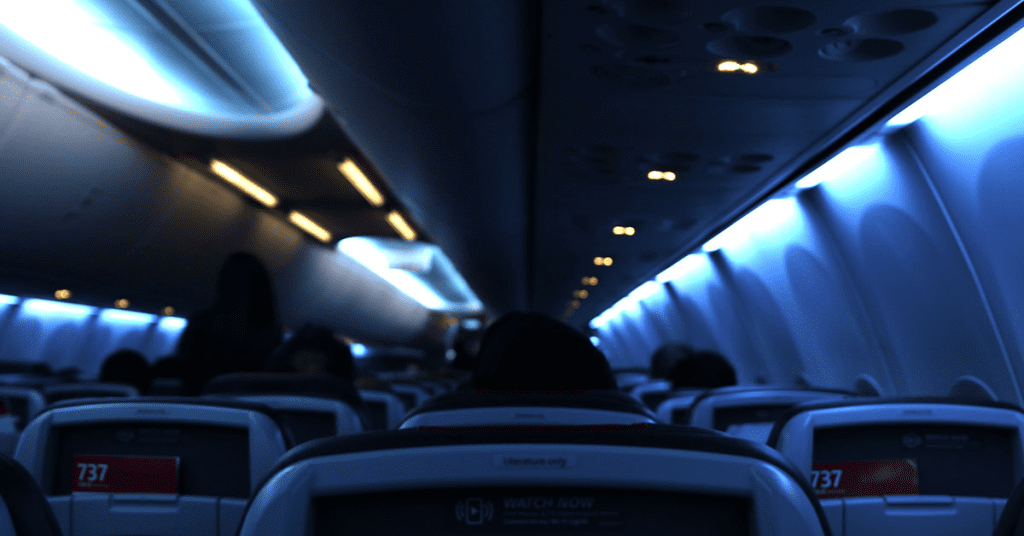If you’ve flown before, you may have noticed that the cabin lights dim during takeoff and landing. While it might seem like this is done to create a cozy atmosphere or help you fall asleep, there’s actually a far more important reason behind this standard practice. Dimming the lights is a crucial safety measure aimed at preparing passengers and crew for potential emergencies. Let’s explore why this seemingly small action plays a significant role in air travel safety.

Safety Precaution: Helping Your Eyes Adjust to Darkness
The primary reason airline crews dim the cabin lights is to help passengers’ and crew members’ eyes adjust to lower light levels, especially during takeoff and landing—two of the most critical phases of flight. According to Dan Bubb, a former airline pilot and associate professor at the University of Nevada, Las Vegas, “during dawn, dusk, and night, flight crews dim the lights so that in case of an emergency where passengers and the flight crew have to abandon the aircraft, their eyes are already adjusted to the dark.”
Your eyes take about 5 to 10 minutes to adjust fully from bright light to darkness. This adjustment period is crucial because, in the event of an emergency evacuation, passengers need to be able to see clearly in low-light conditions. Whether it’s identifying emergency exits or following illuminated floor path lighting, dimming the lights ensures your eyes are prepared for an emergency scenario.
Critical Phases of Flight: Why Timing Matters
Takeoff and landing are known as the most dangerous times during a flight. According to Boeing, about 21% of fatal accidents occur during takeoff and the initial climb, and an even more significant 46% of fatal accidents happen during final descent and landing. This is why airlines are especially cautious during these periods.
During these phases, pilots are extremely busy managing various systems on the aircraft, following air traffic control instructions, and scanning the environment. The plane is also in a “dirty configuration,” meaning the landing gear is down and the flaps are extended—both of which make the aircraft more susceptible to issues. By dimming the cabin lights, crews can ensure passengers are better prepared should anything go wrong during these high-risk phases of flight.
Enhancing Emergency Preparedness
Another important aspect of dimming the lights is improving visibility of emergency signs and pathways in the cabin. In the event of an emergency, dimmed lights make it easier to see the illuminated emergency exit signs and the floor path lighting that directs passengers toward exits. Former United Airlines flight attendant Sue Fogwell emphasizes, “The lights in the cabin are dimmed at dusk and when it’s dark out so your eyesight can adjust in order to more easily evacuate the aircraft.”
In a panic situation, people often struggle to find their bearings, and anything that improves visual clarity is essential. By dimming the lights, airlines are giving passengers the best chance to quickly find their way to an exit, reducing confusion and improving the overall efficiency of evacuations.
Other Lighting Adjustments: Beyond Dimming the Lights

Credit: Pixabay
Dimming the cabin lights isn’t the only safety precaution during takeoff and landing. Flight attendants also ask passengers to complete a few other actions that enhance overall preparedness:
- Tray Tables Stowed: Tray tables must be stowed during these phases to ensure there’s a clear path for passengers to exit in the case of an emergency.
- Bags Stowed: Loose items and bags must be placed under the seat or in overhead bins to prevent tripping hazards.
- Seats Upright: Passengers are asked to return their seat to the upright position to maintain clear egress routes and reduce the chance of injury.
- Window Shades Raised: Another critical action involves raising window shades. As airline pilot Patrick Smith explains, “Raising your window shade during takeoff and landing makes it easier for the flight attendants to assess any exterior hazards—fire, debris—that might interfere with an emergency evacuation.”
These actions work together to create an optimal environment for quick and efficient passenger movement in the unlikely event of an emergency.
Conserving Energy and Promoting Passenger Comfort
In addition to the safety benefits, dimming the lights during nighttime flights also serves to conserve energy and create a more restful atmosphere for passengers. Once takeoff is complete, flight attendants often keep the cabin lights dimmed to promote relaxation. This helps passengers settle in, whether they’re trying to sleep or simply enjoy a calmer environment.
Dim lighting encourages passengers to unwind, and it’s especially useful on long-haul or overnight flights when rest is essential. While comfort is a nice side benefit, the primary reason for dimming the lights remains safety.

Credit: Pixabay
Final Thoughts: It’s All About Safety
The next time you notice the cabin lights dimming during takeoff or landing, remember that it’s not just about making the environment cozy or helping you get some sleep. It’s a crucial safety procedure designed to help your eyes adjust to low-light conditions and prepare you for any emergency evacuation. This small but significant measure is just one of the many ways airlines ensure your flight experience is as safe as possible.
Alongside other safety practices—such as stowing your bags, closing tray tables, and raising window shades—dimming the lights plays an important role in creating optimal conditions for a safe flight. It’s these thoughtful, precautionary actions that help protect everyone on board, even when we might not notice.



